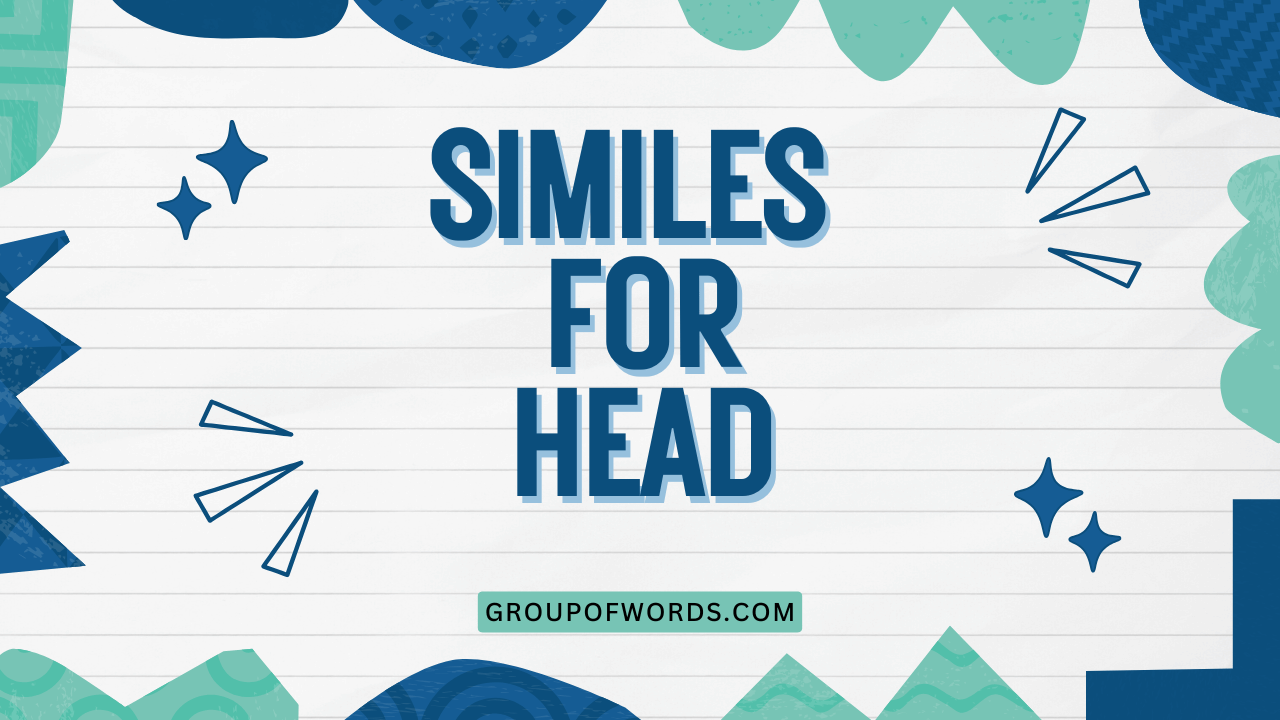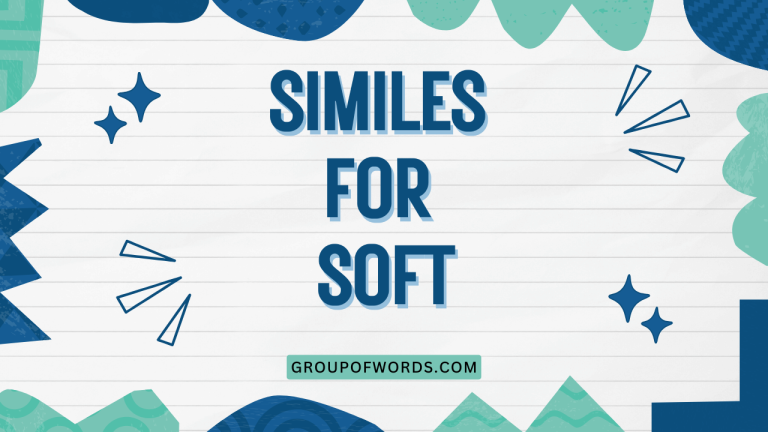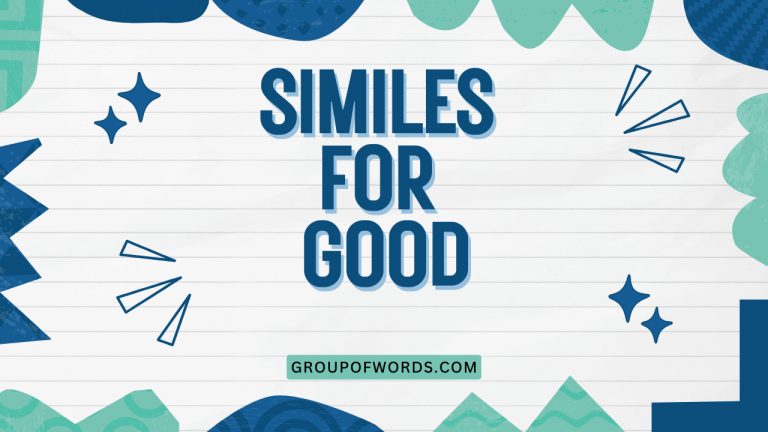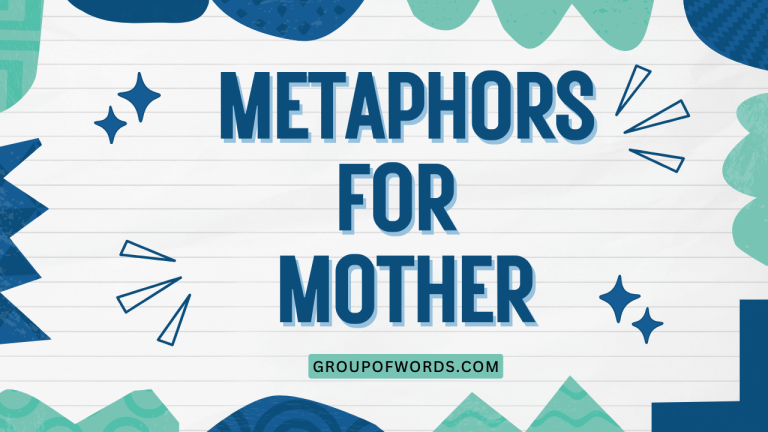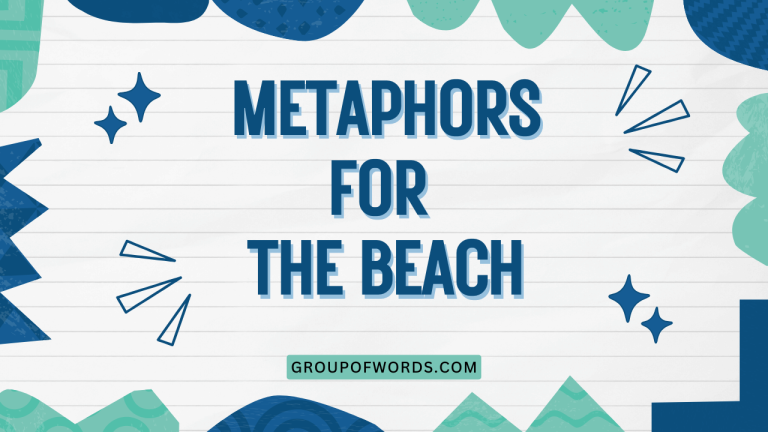Similes for Head: Expanding Your Figurative Language Skills
Understanding and using similes effectively is crucial for enriching your writing and communication. Similes, a type of figurative language, allow you to create vivid comparisons that make your descriptions more engaging and memorable.
This article focuses specifically on similes that describe the “head,” exploring various ways to convey its size, shape, condition, and function. Whether you’re a student, writer, or language enthusiast, this guide will provide you with a comprehensive understanding of similes for the head, complete with examples, practice exercises, and helpful tips.
By mastering these similes, you can add depth and nuance to your descriptions, making your writing more compelling and expressive. This article is designed to be accessible to learners of all levels, from beginners to advanced English speakers.
We’ll break down the concept of similes, explore different categories, and provide ample opportunities for practice. Let’s dive in and unlock the power of figurative language!
Table of Contents
- Introduction
- Definition of Simile
- Structural Breakdown of Similes
- Categories of Similes for Head
- Similes Describing Size
- Similes Describing Shape
- Similes Describing Condition
- Similes Describing Function
- Similes describing Mental State
- Examples of Similes for Head
- Usage Rules for Similes
- Common Mistakes with Similes
- Practice Exercises
- Advanced Topics in Similes
- Frequently Asked Questions
- Conclusion
Definition of Simile
A simile is a figure of speech that compares two unlike things using the words “like” or “as.” The purpose of a simile is to create a vivid image or to emphasize a particular quality by drawing a parallel between the two things being compared. Similes enhance writing by making it more descriptive, engaging, and memorable. They allow the reader to understand a concept or image in a new and interesting way.
Similes are classified as a type of figurative language, falling under the broader category of metaphors. However, unlike metaphors, which directly state that one thing *is* another, similes use “like” or “as” to indicate a comparison.
This distinction is crucial for understanding how similes function within a sentence. The function of a simile is to clarify, emphasize, or add beauty to writing by making abstract ideas more concrete and relatable.
They are commonly used in literature, poetry, and everyday conversation.
In the context of describing the “head,” similes can be used to convey a wide range of characteristics, from its size and shape to its condition and the mental state it reflects. By using imaginative comparisons, you can create a more compelling and nuanced portrait of a person or character.
Structural Breakdown of Similes
The basic structure of a simile consists of three key elements: the subject, the connecting word (either “like” or “as”), and the object of comparison. The subject is the thing being described, the connecting word establishes the comparison, and the object of comparison provides the basis for the comparison. Understanding this structure is essential for constructing effective similes.
Here’s a breakdown of the structural elements:
- Subject: The thing being described (e.g., “His head”)
- Connecting Word: “Like” or “as”
- Object of Comparison: The thing being compared to the subject (e.g., “a bowling ball”)
Putting it all together, a simile might look like this: “His head was like a bowling ball.” In this example, “His head” is the subject, “like” is the connecting word, and “a bowling ball” is the object of comparison. The simile suggests that the person’s head is large and round, similar to a bowling ball.
Similes can also be more complex, incorporating additional descriptive words or phrases to enhance the comparison. For example: “Her head felt as heavy as a lead weight after the long day.” In this case, the simile includes the phrase “heavy as a lead weight,” which adds more detail to the comparison and emphasizes the feeling of exhaustion.
The order of the elements can sometimes be varied for stylistic effect, but the core structure remains the same. For instance, you could say, “As round as a melon, his head bobbed in the water.” While the order is different, the simile still uses “as” to compare the head to a melon, emphasizing its round shape.
Categories of Similes for Head
Similes for the head can be categorized based on the aspect of the head they describe. These categories help to organize and understand the different ways similes can be used to create vivid descriptions.
We will explore similes related to size, shape, condition, function, and mental state.
Similes Describing Size
These similes focus on comparing the size of the head to other objects or concepts. They can emphasize whether the head is large, small, or average in size.
These similes are useful for creating a visual image of the person’s head and can be used to highlight certain characteristics or features.
Similes Describing Shape
These similes focus on comparing the shape of the head to other objects. They can describe the head as being round, square, oval, or any other shape.
These similes are particularly useful for creating a detailed and accurate physical description of a person.
Similes Describing Condition
These similes focus on the physical or emotional condition of the head. They can describe the head as being hot, cold, heavy, light, or any other condition.
These similes are useful for conveying the character’s physical or emotional state.
Similes Describing Function
These similes focus on the functions of the head, such as thinking, remembering, or understanding. They can describe the head as being sharp, dull, empty, or full.
These similes are useful for conveying the character’s mental abilities or state of mind.
Similes describing Mental State
These similes focus on the mental state or condition associated with the head. This could include feelings of confusion, clarity, pressure, or emptiness.
These similes are particularly useful for internal monologues or describing a character’s internal experience.
Examples of Similes for Head
Here are some examples of similes for the head, organized by category. Each category provides a range of examples to illustrate the different ways similes can be used to describe the head.
Size Examples
These similes compare the size of the head to various objects, emphasizing whether it is large, small, or average in size.
The following table presents several examples of similes used to describe the size of a head. These examples provide a range of comparisons, illustrating how different objects can be used to convey the size of the head.
| Simile | Explanation |
|---|---|
| His head was like a bowling ball. | Emphasizes a large, round head. |
| Her head was as small as a peanut. | Emphasizes a very small head. |
| His head looked like a watermelon on a toothpick. | Highlights a disproportionately large head on a thin neck. |
| Her head was like a pea on a mountain. | Illustrates a tiny head on a large body. |
| His head felt as big as a balloon, filled with air. | Suggests a feeling of lightness and emptiness despite its size. |
| Her head was like a shrunken apple. | Implies a small and withered head. |
| His head was the size of a basketball. | A straightforward comparison to a large, round object. |
| Her head was no bigger than a grapefruit. | Another comparison to a relatively small fruit. |
| His head appeared as large as a beach ball. | Exaggerates the size of the head. |
| Her head was like a pinhead on a giant’s body. | Emphasizes the extreme smallness of the head. |
| His head seemed as massive as a boulder. | Suggests a very large and heavy head. |
| Her head was like a pebble in a vast landscape. | Highlights the insignificance of the head in proportion to the body. |
| His head was as round and large as a pumpkin. | A fall-themed comparison emphasizing roundness and size. |
| Her head was like a tiny bud on a thick stem. | Illustrates a small head on a robust neck. |
| His head was as enormous as a globe. | Exaggerates the size, suggesting a world of thoughts inside. |
| Her head resembled a miniature coconut. | A tropical comparison for a small, round head. |
| His head was like a giant egg perched atop his shoulders. | Conveys the image of a large, oval-shaped head. |
| Her head was akin to a thimble, barely visible. | Emphasizes the extreme smallness and insignificance of the head. |
| His head appeared as voluminous as a hot air balloon. | Highlights the large size and the sense of being filled with air or ideas. |
| Her head was like a small button on a large coat. | Illustrates a tiny head in proportion to a larger body. |
| His head was as bulky as a medicine ball. | Suggests a large, heavy, and round head. |
| Her head was similar to a marble, small and smooth. | Compares the head to a small, round object, emphasizing its smoothness. |
| His head was like a colossal dome. | Implies a large, rounded head with a sense of grandeur. |
| Her head was as petite as a cherry. | Emphasizes the small size and roundness of the head. |
| His head resembled a cannonball, solid and large. | Conveys the image of a heavy, round, and imposing head. |
Shape Examples
These similes compare the shape of the head to different objects, emphasizing its roundness, squareness, or other distinct forms.
The following table provides various examples of similes that describe the shape of a head. These comparisons use different objects to illustrate the head’s form, whether it’s round, square, or uniquely shaped.
| Simile | Explanation |
|---|---|
| His head was shaped like a lightbulb. | Suggests a rounded top and narrower bottom. |
| Her head was as round as a globe. | Emphasizes perfect roundness. |
| His head was like a square block. | Highlights a boxy, angular shape. |
| Her head resembled an egg. | Suggests an oval shape, wider at the top. |
| His head was as flat as a pancake. | Emphasizes a flattened or compressed shape. |
| Her head was like a pointed cone. | Highlights a sharp, angular shape. |
| His head was shaped like an anvil. | Suggests a sturdy, blocky shape. |
| Her head was as smooth as a billiard ball. | Emphasizes a perfectly round and smooth shape. |
| His head resembled a lopsided pear. | Suggests an uneven, rounded shape. |
| Her head was like a misshapen potato. | Highlights an irregular, bumpy shape. |
| His head was as angular as a diamond. | Emphasizes sharp, distinct angles. |
| Her head was shaped like a heart, with a widow’s peak. | Highlights a distinctive heart-shaped hairline. |
| His head was like a rounded pyramid. | Suggests a shape that is both round and angular. |
| Her head was as oblong as a rugby ball. | Emphasizes an elongated, oval shape. |
| His head resembled a flattened sphere. | Suggests a round shape that has been compressed. |
| Her head was like a smooth, river stone. | Highlights a rounded, polished shape. |
| His head was shaped like an inverted triangle. | Suggests a wider top and narrower bottom. |
| Her head was as symmetrical as a perfectly drawn circle. | Emphasizes perfect roundness and balance. |
| His head resembled a worn-out football. | Suggests an elongated, slightly deflated shape. |
| Her head was like a bumpy gourd. | Highlights an irregular, rounded shape with bumps. |
| His head was shaped like a half-moon. | Suggests a crescent shape. |
| Her head was as sleek as an upturned boat. | Emphasizes a smooth, curved shape. |
| His head resembled a jagged rock. | Suggests a rough, uneven shape. |
| Her head was like a polished gemstone, multifaceted and unique. | Highlights an intricate, unique shape. |
| His head was shaped like a loaf of bread. | Suggests a rectangular, slightly rounded shape. |
Condition Examples
These similes describe the physical or emotional condition of the head, such as feeling heavy, light, hot, or cold.
The following table provides examples of similes used to describe the condition of a head. These examples illustrate how different comparisons can convey the physical or emotional state of the head.
| Simile | Explanation |
|---|---|
| His head felt as heavy as lead. | Emphasizes a feeling of weight and pressure. |
| Her head was throbbing like a drum. | Highlights a painful, rhythmic sensation. |
| His head felt like it was full of cotton. | Suggests a feeling of fogginess and confusion. |
| Her head was as light as a feather. | Emphasizes a feeling of lightness and detachment. |
| His head felt like it was going to explode. | Highlights intense pressure and pain. |
| Her head was spinning like a top. | Suggests dizziness and disorientation. |
| His head felt as cold as ice. | Emphasizes a feeling of numbness and lack of sensation. |
| Her head was burning like fire. | Highlights a feeling of intense heat and pain. |
| His head felt like it was in a vise. | Suggests a feeling of being squeezed and constricted. |
| Her head was buzzing like a beehive. | Highlights a feeling of activity and confusion. |
| His head felt as empty as a hollow shell. | Emphasizes a feeling of emptiness and lack of thought. |
| Her head was pounding like a hammer. | Highlights a strong, repetitive pain. |
| His head felt like it was underwater. | Suggests a muffled, disoriented sensation. |
| Her head was aching like an old wound. | Emphasizes a persistent, dull pain. |
| His head felt as fragile as glass. | Suggests a feeling of vulnerability and sensitivity. |
| Her head was stiff as a board. | Highlights a feeling of tension and rigidity. |
| His head felt like it was full of static. | Suggests a feeling of agitation and restlessness. |
| Her head was as clear as a bell after a good night’s sleep. | Emphasizes a feeling of clarity and alertness. |
| His head felt like it was wrapped in a fog. | Suggests a feeling of confusion and disorientation. |
| Her head was vibrating like a tuning fork. | Highlights a subtle, resonating sensation. |
| His head felt as tight as a drumhead. | Emphasizes a feeling of tension and pressure. |
| Her head was as clear as a freshly cleaned window. | Highlights a feeling of mental clarity and sharpness. |
| His head felt like it was filled with sand. | Suggests a heavy, gritty sensation. |
| Her head was as numb as a frozen limb. | Emphasizes a complete lack of sensation. |
| His head felt like it was about to split open. | Suggests extreme pressure and pain. |
Function Examples
These similes describe the functions of the head, such as thinking, remembering, or understanding, emphasizing its capabilities or lack thereof.
The following table provides examples of similes used to describe the function of a head. These examples illustrate how different comparisons can convey the mental abilities or state of mind associated with the head.
| Simile | Explanation |
|---|---|
| His head was like a steel trap. | Emphasizes sharpness and quick thinking. |
| Her head was as empty as a drum. | Highlights a lack of thought or intelligence. |
| His head was like a well-oiled machine. | Suggests efficiency and smooth functioning. |
| Her head was as sharp as a tack. | Emphasizes intelligence and wit. |
| His head was like a sieve, ideas slipping through. | Highlights a poor memory. |
| Her head was a storehouse of knowledge. | Emphasizes a wealth of information. |
| His head was as muddled as a swamp. | Suggests confusion and unclear thinking. |
| Her head was like a computer, processing information. | Emphasizes logical and systematic thinking. |
| His head was as blank as a chalkboard. | Highlights a lack of ideas or understanding. |
| Her head was a fountain of creativity. | Emphasizes a constant flow of new ideas. |
| His head was like a rusty cog, slow to turn. | Suggests slow and labored thinking. |
| Her head was as clear as a crystal. | Emphasizes clarity of thought and understanding. |
| His head was like a tangled web. | Suggests complex and confused thinking. |
| Her head was a library of memories. | Emphasizes a strong and vivid memory. |
| His head was as dull as a butter knife. | Highlights a lack of intelligence or wit. |
| Her head was like a switchboard, connecting ideas. | Emphasizes the ability to make connections and understand relationships. |
| His head was as disorganized as a junk drawer. | Suggests a lack of focus and structure in thinking. |
| Her head was a beacon of insight. | Emphasizes wisdom and understanding. |
| His head was like a locked vault, secrets kept safe. | Highlights the ability to keep secrets and hold onto information. |
| Her head was as quick as a hummingbird. | Emphasizes fast and agile thinking. |
| His head was like a sponge, soaking up information. | Highlights the ability to absorb and retain knowledge. |
| Her head was as precise as a laser beam. | Emphasizes accuracy and focus in thinking. |
| His head was like a sieve, retaining only the unimportant details. | Highlights a poor memory for essential information. |
| Her head was a treasure trove of ideas. | Emphasizes a wealth of creative and innovative thoughts. |
| His head was as slow as molasses in January. | Suggests extremely slow and labored thinking. |
Mental State Examples
These similes describe the mental state or condition associated with the head, such as confusion, clarity, pressure, or emptiness.
The following table provides examples of similes used to describe the mental state associated with a head. These examples illustrate how different comparisons can convey the emotional and mental condition of the person.
| Simile | Explanation |
|---|---|
| His head felt like it was in the clouds. | Suggests a feeling of detachment and confusion. |
| Her head was as clear as a mountain stream. | Emphasizes clarity and focus. |
| His head felt like a pressure cooker. | Highlights intense stress and anxiety. |
| Her head was as empty as a deserted house. | Emphasizes a lack of thoughts or feelings. |
| His head felt like it was full of static. | Suggests agitation and restlessness. |
| Her head was a calm and peaceful sanctuary. | Emphasizes tranquility and mental peace. |
| His head felt like it was wrapped in a fog. | Suggests confusion and disorientation. |
| Her head was as light as a summer breeze. | Emphasizes a feeling of freedom and ease. |
| His head felt like it was being squeezed in a vise. | Highlights intense pressure and stress. |
| Her head was a vibrant garden of thoughts. | Emphasizes creativity and mental activity. |
| His head felt as heavy as a stone. | Suggests a burden of thoughts and worries. |
| Her head was as bright as a sunny day. | Emphasizes optimism and clarity. |
| His head felt like it was spinning out of control. | Suggests chaos and loss of focus. |
| Her head was a quiet and still pond. | Emphasizes calmness and serenity. |
| His head felt like it was bursting with ideas. | Highlights creativity and inspiration. |
| Her head was as dark as a moonless night. | Emphasizes sadness and despair. |
| His head felt like it was on fire. | Suggests intense anger or passion. |
| Her head was as steady as a rock. | Emphasizes stability and resilience. |
| His head felt like it was being pulled in different directions. | Highlights internal conflict and confusion. |
| Her head was a wellspring of wisdom. | Emphasizes knowledge and understanding. |
| His head felt as numb as a frozen tundra. | Suggests emotional detachment and apathy. |
| Her head was as radiant as a star. | Emphasizes brilliance and insight. |
| His head felt like it was trapped in a maze. | Suggests confusion and a lack of direction. |
| Her head was a sanctuary of peace and tranquility. | Emphasizes inner calmness and serenity. |
| His head felt like it was about to shatter. | Suggests extreme stress and vulnerability. |
Usage Rules for Similes
Using similes effectively requires understanding a few key rules. Firstly, ensure that the comparison is clear and relevant.
The object of comparison should have a quality that is easily recognizable and applicable to the subject. Secondly, avoid clichés.
Overused similes can make your writing sound unoriginal and predictable. Instead, strive to create fresh and imaginative comparisons.
Another important rule is to maintain consistency in tone and style. The simile should fit the overall mood and purpose of your writing.
A humorous simile might be inappropriate in a serious or formal context. Additionally, be mindful of the audience.
The object of comparison should be something that your readers are likely to understand and relate to.
Here are some specific guidelines to follow:
- Clarity: The comparison should be easily understood.
- Originality: Avoid overused similes.
- Consistency: The simile should fit the tone and style of your writing.
- Relevance: The object of comparison should be relevant to the subject.
- Audience: Consider your audience’s knowledge and understanding.
By following these rules, you can use similes effectively to enhance your writing and make it more engaging and memorable.
Common Mistakes with Similes
One common mistake is using similes that are clichés or overused. For example, saying “His head was as hard as a rock” is a simile, but it lacks originality and impact.
A more effective simile might be “His head was as hard as granite, unyielding to reason.” Another mistake is using similes that are confusing or illogical. The comparison should be clear and make sense to the reader.
Another frequent error is mixing metaphors and similes. While both are figures of speech, they function differently.
A simile uses “like” or “as” to make a comparison, while a metaphor directly states that one thing *is* another. Mixing the two can create awkward or nonsensical sentences.
For instance, saying “His head was a rock, like a fortress” incorrectly combines a metaphor (“His head was a rock”) with a simile (“like a fortress”).
Here are some examples of common mistakes and how to correct them:
| Incorrect | Correct | Explanation |
|---|---|---|
| His head was as hard as a rock. | His head was as hard as granite, unyielding to reason. | The corrected version is more original and descriptive. |
| Her head was like a car, but also a train. | Her head was like a speeding train, full of ideas. | The corrected version provides a single, coherent comparison. |
| His head was a rock, like a fortress. | His head was like a fortress, impenetrable and strong. | The corrected version maintains a consistent simile structure. |
| Her head was as clear as mud. | Her head was as clear as a crystal stream. | The corrected version uses a logical and understandable comparison. |
| His head was like a sieve, but a steel trap for information. | His head was like a sieve, letting important details slip through. | The corrected version maintains a consistent comparison throughout. |
Practice Exercises
Test your understanding of similes for the head with these practice exercises. Each exercise provides a sentence or phrase that needs to be completed with an appropriate simile.
Exercise 1: Complete the Simile
Complete the following sentences with an appropriate simile using “like” or “as.”
| Question | Answer |
|---|---|
| 1. His head felt ____________________ after the long meeting. | His head felt as heavy as lead after the long meeting. |
| 2. Her head was shaped ____________________. | Her head was shaped like an egg. |
| 3. His head was ____________________ when trying to solve the puzzle. | His head was as empty as a drum when trying to solve the puzzle. |
| 4. Her head was spinning ____________________. | Her head was spinning like a top. |
| 5. His head was ____________________, full of brilliant ideas. | His head was like a well-oiled machine, full of brilliant ideas. |
| 6. Her head felt ____________________ after the shock. | Her head felt as cold as ice after the shock. |
| 7. His head was as big ____________________. | His head was as big as a watermelon. |
| 8. Her head was throbbing ____________________. | Her head was throbbing like a drum. |
| 9. His head felt ____________________ after the argument. | His head felt as heavy as a stone after the argument. |
| 10. Her head was ____________________ with creative thoughts. | Her head was like a fountain with creative thoughts. |
Exercise 2: Identify the Simile
Identify the simile in each of the following sentences.
| Question | Answer |
|---|---|
| 1. His head was as round as a basketball. | as round as a basketball |
| 2. Her head felt like it was going to explode. | like it was going to explode |
| 3. His head was a steel trap, ready to snap shut on any idea. | was a steel trap |
| 4. Her head was as clear as a mountain stream, pure and refreshing. | as clear as a mountain stream |
| 5. His head felt like a pressure cooker, ready to burst. | like a pressure cooker |
| 6. Her head was as empty as a deserted house, devoid of thoughts. | as empty as a deserted house |
| 7. His head felt like it was wrapped in a fog, thick and disorienting. | like it was wrapped in a fog |
| 8. Her head was as light as a summer breeze, carefree and relaxed. | as light as a summer breeze |
| 9. His head was like a sponge, soaking up every word. | like a sponge |
| 10. Her head was a beacon of insight, shining brightly with understanding. | was a beacon of insight |
Exercise 3: Rewrite with a Simile
Rewrite the following sentences using a simile to describe the head.
| Question | Answer |
|---|---|
| 1. His head was very large. | His head was like a giant globe. |
| 2. Her head was spinning. | Her head was spinning like a top. |
| 3. His head felt heavy. | His head felt as heavy as lead. |
| 4. Her head was full of ideas. | Her head was like a beehive, buzzing with ideas. |
| 5. His head was clear and focused. | His head was as clear as a mountain stream. |
| 6. Her head was throbbing with pain. | Her head was throbbing like a drum. |
| 7. His head was empty of thoughts. | His head was as empty as a deserted house. |
| 8. Her head was cold and numb. | Her head was as cold as ice. |
| 9. His head was hot and feverish. | His head was burning like fire. |
| 10. Her head was light and carefree. | Her head was as light as a feather. |
Advanced Topics in Similes
Beyond the basics, advanced simile usage involves creating nuanced and layered comparisons. This includes using similes to convey complex emotions, abstract concepts, and subtle details.
Advanced users also understand how to combine similes with other figures of speech to create richer, more evocative prose.
One advanced technique is the use of extended similes, where the comparison is developed over several sentences or even paragraphs. This allows for a more detailed and immersive description.
Another technique is the use of ironic or paradoxical similes, where the comparison is unexpected or contradictory, creating a sense of tension or humor.
Additionally, advanced users are adept at tailoring their similes to specific contexts and audiences. This involves considering the cultural background, knowledge, and expectations of the readers, and choosing comparisons that will resonate with them.
Consider the following advanced techniques:
- Extended Similes: Developing the comparison over multiple sentences.
- Ironic Similes: Using unexpected or contradictory comparisons.
- Contextual Tailoring: Adapting similes to specific audiences and situations.
Frequently Asked Questions
What is the difference between a simile and a metaphor?
A simile compares two things using “like” or “as,” while a metaphor directly states that one thing *is* another. Similes are more explicit in their comparison, whereas metaphors are more implicit.
How can I avoid using clichés in my similes?
To avoid clichés, try to think of original and unexpected comparisons. Use specific and descriptive language, and consider the unique qualities of the subject you are describing.
Can a simile be too complex?
Yes, a simile can be too complex if it is difficult to understand or if the comparison is too obscure. The best similes are clear, concise, and relevant to the subject.
How do I choose the right object of comparison for a simile?
Choose an object of comparison that shares a relevant quality with the subject you are describing. Consider the context, tone, and audience of your writing when making your choice.
Are similes only used in writing?
No, similes are also used in everyday conversation to make descriptions more vivid and engaging. They are a common tool in both written and spoken language.
Conclusion
Mastering the art of using similes to describe the “head” can significantly enhance your writing and communication skills. By understanding the structure, categories, and usage rules of similes, you can create vivid and memorable descriptions that engage your audience.
Remember to avoid clichés, maintain consistency in tone, and tailor your similes to specific contexts and audiences.
Through practice and experimentation, you can develop your own unique style of using similes and unlock the full potential of figurative language. Whether you’re writing a novel, a poem, or a simple email, the ability to craft effective similes will make your words more impactful and expressive.
